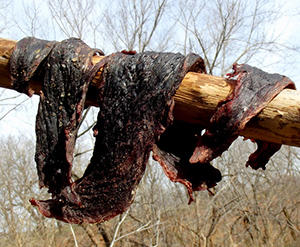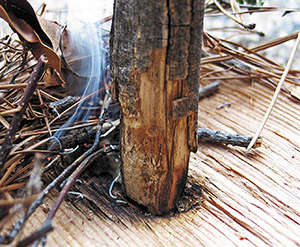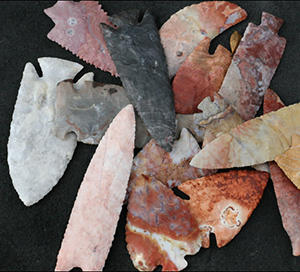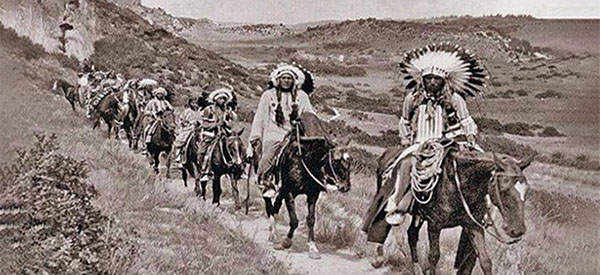Some people tend to think of survival as a modern thing, made possible by modern tools, equipment and techniques. However, there was a time when most people’s everyday lives were pretty close to the survival scenarios we prepare for today.
Many of the survival techniques we use were perfected by the primitive cultures of yesteryear, and those cultures managed to survive for centuries without any of the modern gear we make use of today.
The Native Americans, for example, were undeniably very talented at the art of survival. The various tribes across the Americas managed to not only survive using what they collected from the land around them, but to thrive for thousands of years.
Portable Foods
Anyone who has ever hunted knows that it doesn’t always go your way. There’s an old saying that goes, “If you caught something every time you went hunting it wouldn’t be called hunting; it would be called catching.” With no grocery stores or pantries full of canned goods, and the fact that you can’t ever count on getting meat just because you went hunting, Native Americans had to put back food for lean times.
Jerky
 Because they had no modern methods of preservation they turned to dried meat, which we now refer to as jerky. While they didn’t have the fancy dehydrators, either electric or solar, that we have today, they made do. They used the open air, heat from a fire, and simple drying racks to preserve meat and make it easily portable.
Because they had no modern methods of preservation they turned to dried meat, which we now refer to as jerky. While they didn’t have the fancy dehydrators, either electric or solar, that we have today, they made do. They used the open air, heat from a fire, and simple drying racks to preserve meat and make it easily portable.
Pemmican
This Native American food was unique to certain tribes. Pemmican’s main ingredient was jerky, but it also incorporated rendered animal fats and fruits (usually berries), veggies, and herbs in order to create a more complete meal. Pulverized jerky, dried berries and fat were mixed together and rolled into serving-sized balls that could be stored safely for months. There are lots of pemmican recipes out there if you’d like to try it for yourself!
Corn
Cornmeal was used to make several common Native American foods; it was also easy to carry, and kept for long periods of time.
Soft, Flexible Footwear
The ability to get around quickly and quietly was crucial to the Native American’s ability to procure their own food by hunting and to stay safe in areas where they might encounter members of hostile tribes. To do this, they needed footwear that would both protect their feet and allow them to travel stealthily.
To serve their purposes, their footwear was soft but tough, and fit close to the feet so that they could move adeptly and quietly through their environment. The nature of their shoes varied by the area that they hailed from and based on their lifestyle.
This functional footwear was often referred to as a moccasin, and they were made with hard or soft soles dependent on the ground that they’d be required to traverse. The designs varied from remarkably simple, everyday walking shoes to highly decorated ceremonial shoes.
Related: How to Make Your Boots Last Longer
Fire Starting Materials

We all know that the ability to make fire is imperative to survival. Fire allows us to make our food and water safe, provides warmth, and deters predators from moving in on our territory. For some tribes of Native Americans, it was a tool in and of itself. They used it to clear land for homes and fields and to take care of any pests set on invasion. Here are a few of the most common fire starters.
Mineral Fire Starters
Starting fires with rocks was a common method for Native Americans for centuries. Originally, they used any stones that could strike a spark. Later, as they gained access to metal from European settlers, they began using flint and steel. They carried these, along with the other materials they needed to start a fire, in a pouch so that they could get a blaze going at a moment’s notice.
Bow Drill
The bow drill is a primitive fire starter that is still popular today amongst survivalists. It uses a wooden bow with a string that wraps around a straight stick; one end of this stick goes into a small hole in a wooden fire board, and the other is held steady using a seashell or a small block of wood. Moving the bow back and forward like a saw spins the straight stick fast enough that friction generates a lot of heat, and tinder piled around the hole in the fire board will soon ignite.
Fire Drill
A fire drill uses a wooden stick moved manually against a fire board to create friction. The friction eventually created enough heat to cause a spark which could light dried tinder to create a tiny coal that could be built up into a roaring blaze. This method is a lot slower than a bow drill, but you can use it even if you have nothing to improvise a bowstring from.
Related: How to Make Firebricks (fire logs) and Wood Stove Logs for Free!
A Reliable Blade
 A good blade is exactly as important to survival now as it was to the Native Americans. However, they didn’t have access to the modern metals we have today. Instead, they carved blades from the rocks and minerals in their area. They were skilled craftsmen, and most were capable of creating a sharp blade with very little by way of tools. It was necessary that they could create a new blade on the fly, since stone blades tend to not last very long. That’s likely why it’s so common to find the flint flakes created by blade making.
A good blade is exactly as important to survival now as it was to the Native Americans. However, they didn’t have access to the modern metals we have today. Instead, they carved blades from the rocks and minerals in their area. They were skilled craftsmen, and most were capable of creating a sharp blade with very little by way of tools. It was necessary that they could create a new blade on the fly, since stone blades tend to not last very long. That’s likely why it’s so common to find the flint flakes created by blade making.
Blades were used to hunt and trap, prepare food, and build shelter. They were also used for self-defense and in times of war between tribes. In a survival situation or even in everyday life, these are exactly the things you’d need a good blade for, so it would pay to always have one on your person.
A handy ax
A knife is great, but sometimes you need a bit more force – and the easiest way to do that is to attach a blade to a handle, to give it more leverage. The classic Native American all-purpose tool was the tomahawk. A short, handy ax with a straight shaft, it could be used for splitting wood, chopping meat or as a formidable hand or throwing weapon.
After Europeans arrived tomakawks were usually made with metal heads sold as trade goods, but the traditional design used a sharpened stone or wedge of deer antler, lashed to an ash or hickory shaft with strips of rawhide.
Bow and Arrows
Bows were the primary ranged weapon of the Native Americans. They used their blades and springy wood to build them, and the string material varied by region. Arrowheads were made from flint or other hard stone, just as their blades were. Bows were used for hunting, fishing, and defensive purposes, and most Native Americans were very adept with them.
Animal Hides
Animal hides were used for all sorts of things in Native American culture, and many of these uses were key to survival through the harsh Plains winters. Hides were used as clothing, both to keep warm and to act as camouflage while they were hunting game. After all, the animals had already mastered staying invisible in the terrain.
Hides were also used as shelter. Teepees are just one well-known example of how hides protected Native Americans from the environment.
Easy load carrying
We always think of Native Americans as great horsemen, but until Europeans arrived in the 16th century there were no horses in the Americas – they’d become extinct during the last ice age. With just manpower to move their possessions with, the Native Americans came up with an ingenious solution – the travois.
A travois is a simple frame of three poles – two long and one short – lasted together in an A shape. A frame, cloth or net between the long poles holds the load. Sometimes a harness was attached to the point of the A, or the user could just put their head through that end and let the poles rest on their shoulders. Then they’d simply drag it behind them, with the wide ends trailing on the ground and stabilizing it. A travois will carry a heavier load than you can pack on your back, and it’s a great way of evacuating a casualty if you’re on your own – a sort of one-man stretcher. Best of all, you can improvise one with a few strong poles and a coat.
Taking a Page Out of Their Book
Modern survivalists have a lot to learn from the Native Americans about survival. While they carried these things with them to help ensure their survival, they also focused on learning and perfecting the skills they needed to thrive in their respective environments.
You may also like:
 Tools The Early Pioneers Used on A Daily Basis
Tools The Early Pioneers Used on A Daily Basis
The Native American Food That Is Even Better Than Pemmican (Video)
22 Native American Remedies – Medicinal Plants We Lost To History
$1.70 a Day – 90 Days Emergency Food Kit
11 Things The Pioneers Carried With Them On The Oregon Trail















I’m trying to purchase the lost ways 2 and the 2 bonus books but it wouldn’t open up
Hi Harold,
I have sent you an email regarding your order.
Claude
I paid for the lost book and never got to download it.
Hi Tammy,
I have sent you an email with the link to access and download the book and the 2 bonuses.
Claude
I also ordered your lost ways 2 and never did receive it I do not have the means to download anything, so do not expect me to do that. I was thinking it would be a book, like the picture shows. not a part of the computer.
Jane
Hi Jane,
I have sent you an email regarding your order.
Claude
I have both books and very pleased with them. How -ever, this is the first I’ve heard about any bonus books. Am I missing something? If they are real books send them . If it is something to down load, keep them.
I have both books and never got a download as well. I enjoy the books but the bonuses never came
I purchased the Lost remedies and got it but I have never seen the bonuses.
Hi Jak,
I have sent you an email regarding your order.
Claude
Hi Pappy,
I have sent you an email regarding your order.
Claude
I purchased and received The Book of Lost Remedies. However, I was also charged for other materials which turned out to be digital, which I don’t want, nor could I download them. I need to have these charges reversed. Thank you.
NEVER RECEIVED THE 3 BONUSES THAT WAS OFFERED WITH BOOK I ORDERED..
EDWARD JUTZI
924 W. TENN. STREET
EVANSVILLE INDIANA 47710
THE 3 BONUSES THAT WERE OFFERED WITH THE BOOK YOU ORDERED WERE DOWNLOADS. TRY READING THE PAGE CORRECTLY>
I ordered a BOOK, ie. hard copy in good faith and got the run around. Why would you want to have just a ‘download’ if everything crashes? IF you are really wanting to keep something around, it would need to be in hard copy form. SORRY, but you have lost a customer here.
Claude, I have two of your books. I like what I have but the other bonus books or whatever they are never made it through. If you get a chance, brother, I would appreciate it if you could check on that for me. You opened my eyes to a lot of “things” right in my back yard. Now I am a forager, too! Many thanks for what I DID get! lol
Claude, I ordered physical books lost ways 1 and 2 but can’t retrive the bonus books digitally. What do I do?.
James
Hi Jim,
Thank you so much for purchasing The Lost Ways and The Lost Ways 2.
I am sorry to hear you could not access the bonuses.
I have just sent you an email with the links for the Bonuses.
If there is anything else I can help with, just let me know.
God bless,
Claude
CHIA SEEDS. Indians carried Chia Seeds on a long run journey..